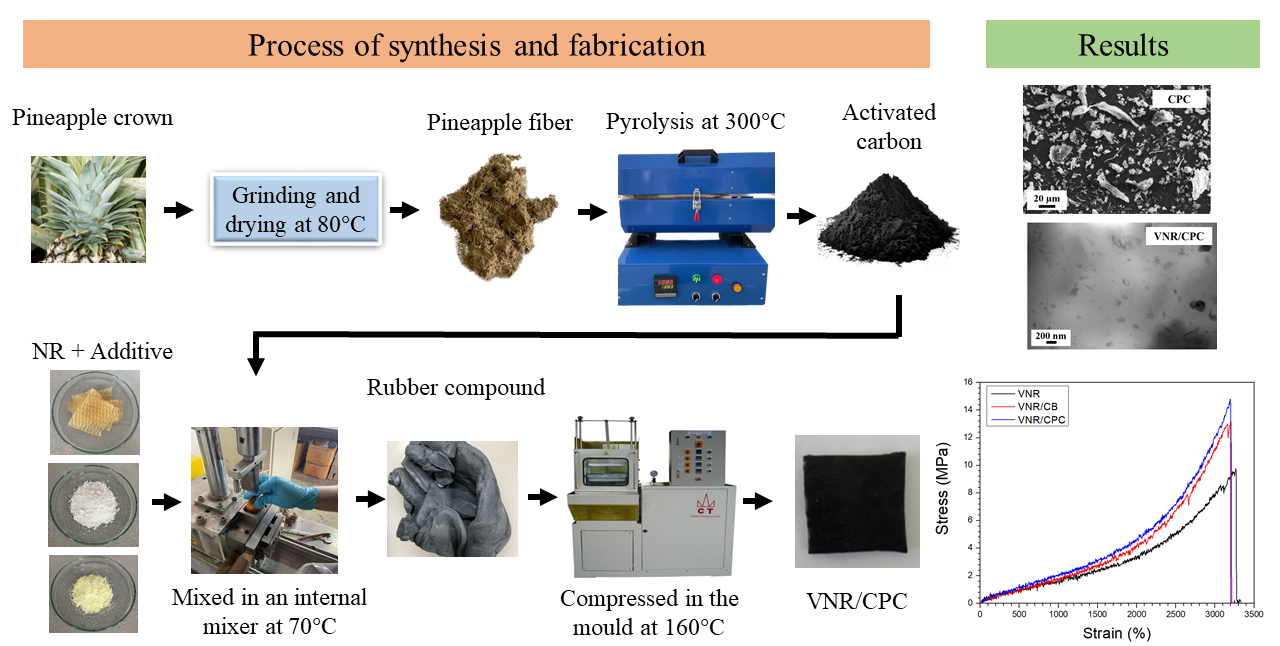 Open Access
Open Access
ARTICLE
Enhancement of Mechanical Properties of Natural Rubber Filled Activated Carbon Materials from Agricultural Waste
Department of Advanced Materials Engineering, Faculty of Engineering, Burapha University, Chonburi, 20131, Thailand
* Corresponding Author: Worawut Muangrat. Email:
Journal of Renewable Materials 2025, 13(4), 817-827. https://doi.org/10.32604/jrm.2025.02024-0017
Received 15 October 2024; Accepted 20 December 2024; Issue published 21 April 2025
Abstract
Herein, cure characteristics, morphology, and mechanical properties of natural rubber filled with activated carbon-based materials were investigated. Carbon-based materials were prepared from bagasse, coffee grounds and pineapple crowns by the pyrolysis method at temperatures in the range of 300°C. As-synthesized carbon materials were characterized by optical microscopy (OM), scanning electron microscopy (SEM), and Fourier-transform infrared spectroscopy (FTIR) to analyze size distribution, morphology, and functional groups, respectively. OM and SEM analysis revealed that particles, flakes, and a small quantity of fiber-like carbon were obtained using bagasse and pineapple crown as raw materials, while honeycomb-like carbon materials can be derived from coffee grounds. To investigate the mechanical properties, natural rubber was filled with carbon black and as-synthesized carbon materials by the internal mixing and compression molding process. Transmission electron microscopy (TEM) was utilized to characterize the dispersion of carbon materials in the rubber matrix. The results of tensile testing showed that the natural rubber mixed with as-synthesized carbon materials from pineapple crowns exhibited 54% and 74% improvement in the ultimate tensile strength and Young’s modulus, respectively, compared with natural rubber without filled carbon materials. The enhancement in mechanical properties by activated carbon materials derived from pineapple crowns can be attributed to the flake- and fiber-like structures and good dispersion of carbon materials in the rubber matrix. In addition, it is higher than that of rubber mixed with carbon black. The results demonstrated that as-synthesized carbon materials from pineapple crowns have the potential materials to substitute carbon black in the rubber compound industry.Graphic Abstract

Keywords
Cite This Article
 Copyright © 2025 The Author(s). Published by Tech Science Press.
Copyright © 2025 The Author(s). Published by Tech Science Press.This work is licensed under a Creative Commons Attribution 4.0 International License , which permits unrestricted use, distribution, and reproduction in any medium, provided the original work is properly cited.


 Submit a Paper
Submit a Paper Propose a Special lssue
Propose a Special lssue View Full Text
View Full Text Download PDF
Download PDF Downloads
Downloads
 Citation Tools
Citation Tools